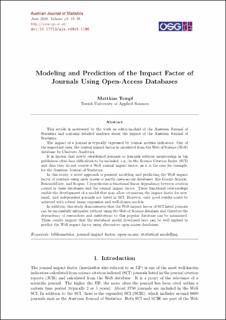Please use this identifier to cite or link to this item:
https://doi.org/10.21256/zhaw-26283| Publication type: | Article in scientific journal |
| Type of review: | Peer review (publication) |
| Title: | Modeling and prediction of the impact factor of journals using open-access databases |
| Authors: | Templ, Matthias |
| et. al: | No |
| DOI: | 10.17713/ajs.v49i5.1186 10.21256/zhaw-26283 |
| Published in: | Austrian Journal of Statistics |
| Volume(Issue): | 49 |
| Issue: | 5 |
| Page(s): | 35 |
| Pages to: | 58 |
| Issue Date: | 2020 |
| Publisher / Ed. Institution: | Austrian Statistical Society |
| ISSN: | 1026-597X |
| Language: | English |
| Subjects: | Bibliometrics; Journal impact factor; Open-access; Statistical modelling |
| Subject (DDC): | 020: Library and information sciences 070: News media, journalism and publishing |
| Abstract: | This article is motivated by the work as editor-in-chief of the Austrian Journal of Statistics and contains detailed analyses about the impact of the Austrian Journal of Statistics. The impact of a journal is typically expressed by journal metrics indicators. One of the important ones, the journal impact factor is calculated from the Web of Science (WoS) database by Clarivate Analytics. It is known that newly established journals or journals without membership in big publishers often face difficulties to be included, e.g., in the Science Citation Index (SCI) and thus they do not receive a WoS journal impact factor, as it is the case for example, for the Austrian Journal of Statistics. In this study, a novel approach is pursued modeling and predicting the WoS impact factor of journals using open access or partly open-access databases, like Google Scholar, ResearchGate, and Scopus. I hypothesize a functional linear dependency between citation counts in these databases and the journal impact factor. These functional relationships enable the development of a model that may allow estimating the impact factor for new, small, and independent journals not listed in SCI. However, only good results could be achieved with robust linear regression and well-chosen models. In addition, this study demonstrates that the WoS impact factor of SCI listed journals can be successfully estimated without using the Web of Science database and therefore the dependency of researchers and institutions to this popular database can be minimized. These results suggest that the statistical model developed here can be well applied to predict the WoS impact factor using alternative open-access databases. |
| URI: | https://digitalcollection.zhaw.ch/handle/11475/26283 |
| Fulltext version: | Published version |
| License (according to publishing contract): | CC BY 3.0: Attribution 3.0 Unported |
| Departement: | School of Engineering |
| Organisational Unit: | Institute of Data Analysis and Process Design (IDP) |
| Appears in collections: | Publikationen School of Engineering |
Files in This Item:
| File | Description | Size | Format | |
|---|---|---|---|---|
| 2020_Templ_Modeling-prediction-impact-factor-journals-using-open-access-databases_AJS.pdf | 404.3 kB | Adobe PDF |  View/Open |
Show full item record
Templ, M. (2020). Modeling and prediction of the impact factor of journals using open-access databases. Austrian Journal of Statistics, 49(5), 35–58. https://doi.org/10.17713/ajs.v49i5.1186
Templ, M. (2020) ‘Modeling and prediction of the impact factor of journals using open-access databases’, Austrian Journal of Statistics, 49(5), pp. 35–58. Available at: https://doi.org/10.17713/ajs.v49i5.1186.
M. Templ, “Modeling and prediction of the impact factor of journals using open-access databases,” Austrian Journal of Statistics, vol. 49, no. 5, pp. 35–58, 2020, doi: 10.17713/ajs.v49i5.1186.
TEMPL, Matthias, 2020. Modeling and prediction of the impact factor of journals using open-access databases. Austrian Journal of Statistics. 2020. Bd. 49, Nr. 5, S. 35–58. DOI 10.17713/ajs.v49i5.1186
Templ, Matthias. 2020. “Modeling and Prediction of the Impact Factor of Journals Using Open-Access Databases.” Austrian Journal of Statistics 49 (5): 35–58. https://doi.org/10.17713/ajs.v49i5.1186.
Templ, Matthias. “Modeling and Prediction of the Impact Factor of Journals Using Open-Access Databases.” Austrian Journal of Statistics, vol. 49, no. 5, 2020, pp. 35–58, https://doi.org/10.17713/ajs.v49i5.1186.
Items in DSpace are protected by copyright, with all rights reserved, unless otherwise indicated.